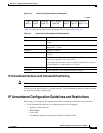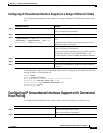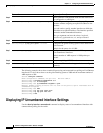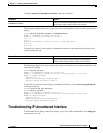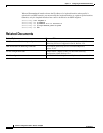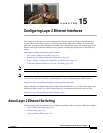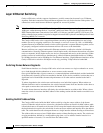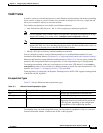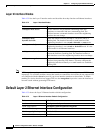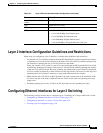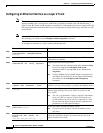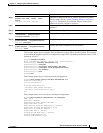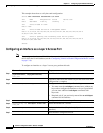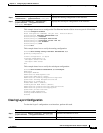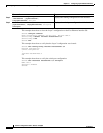
15-3
Software Configuration Guide—Release 15.0(2)SG
OL-23818-01
Chapter 15 Configuring Layer 2 Ethernet Interfaces
About Layer 2 Ethernet Switching
VLAN Trunks
A trunk is a point-to-point link between one or more Ethernet switch interfaces and another networking
device such as a router or a switch. Trunks carry the traffic of multiple VLANs over a single link and
allow you to extend VLANs across an entire network.
Two trunking encapsulations are available on all Ethernet interfaces:
• Inter-Switch Link (ISL) Protocol—ISL is a Cisco-proprietary trunking encapsulation.
Note Catalyst 4900M, Catalyst 4948E, Supervisor Engine 6-E, and Supervisor Engine 6L-E do not
support ISL trunking; you cannot use the switchport trunk encapsulate command.
Note The blocking Gigabit ports on the WS-X4418-GB and WS-X4412-2GB-T modules do not
support ISL. Ports 3 to 18 are blocking Gigabit ports on the WS-X4418-GB module. Ports 1 to
12 are blocking Gigabit ports on the WS-X4412-2GB-T module.
• 802.1Q—802.1Q is an industry-standard trunking encapsulation.
You can configure a trunk on a single Ethernet interface or on an EtherChannel bundle. For more
information about EtherChannel, see Chapter 22, “Configuring EtherChannel and Link State Tracking.”
Ethernet trunk interfaces support different trunking modes (see Table 15-2). You can specify whether the
trunk uses ISL encapsulation, 802.1Q encapsulation, or if the encapsulation type is autonegotiated.
To autonegotiate trunking, make sure your interfaces are in the same VTP domain. Use the trunk or
nonegotiate keywords to force interfaces in different domains to trunk. For more information on VTP
domains, see Chapter 13, “Configuring VLANs, VTP, and VMPS.”
Trunk negotiation is managed by the Dynamic Trunking Protocol (DTP). DTP supports autonegotiation
of both ISL and 802.1Q trunks.
Encapsulation Types
Table 15-1 lists the Ethernet trunk encapsulation types.
The trunking mode, the trunk encapsulation type, and the hardware capabilities of the two connected
interfaces determine whether a link becomes an ISL or 802.1Q trunk.
Table 15-1 Ethernet Trunk Encapsulation Types
Encapsulation Type Encapsulation Command Purpose
ISL
switchport trunk encapsulation isl
Specifies ISL encapsulation on the trunk link.
802.1Q
switchport trunk encapsulation dot1q
Specifies 802.1Q encapsulation on the trunk link.
Negotiate
switchport trunk encapsulation negotiate
Specifies that the interface negotiate with the
neighboring interface to become an ISL (preferred)
or 802.1Q trunk, depending on the configuration
and capabilities of the neighboring interface.



